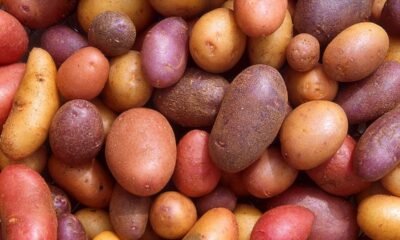Business & Economy
Why Potatoes Are The Unexpected Superstars Of The Produce Aisle In 2025
From affordability to versatility, America’s favorite comfort carb is thriving on grocery shelves and driving sales growth this year.

In a grocery world filled with trendy greens, exotic fruits, and superfood hype, the humble potato is having a breakout moment in 2025 — and retailers are loving it.
Long cherished as a comfort food staple, potatoes are proving they’re much more than just a side dish. In fact, industry insiders say spuds have quietly become a powerhouse at the produce aisle, delivering steady volume and dollar growth when other categories feel the pinch of shifting consumer budgets.
Retail experts point to a few reasons for the potato boom. First and foremost: affordability. As inflation and grocery prices continue to challenge shoppers, potatoes remain one of the best value buys per pound, feeding entire families for just a few dollars. From classic russets and reds to petite fingerlings and colorful varietals, there’s a spud for every budget and recipe.
But it’s not just about cost. Potatoes are riding a wave of popularity thanks to their incredible versatility. Air-fried wedges, mashed bowls, loaded baked potatoes, or trendy smashed potatoes on TikTok — social media has reminded a new generation that spuds are anything but boring. Recipes showcasing quick, healthy, and flavor-packed potato dishes are racking up millions of views and driving demand.
Farmers and distributors have leaned in too. Many growers have introduced premium and specialty potato varieties that appeal to foodies looking for farm-fresh quality and vibrant colors. Clever branding and eye-catching packaging help potatoes stand out in an aisle crowded with greens and fruits.
Retailers say another big win is potatoes’ reliability. Unlike more delicate produce, potatoes store well and have minimal shrink, making them a retailer’s dream when it comes to managing inventory and reducing waste. More stores are using creative merchandising to highlight potato meal solutions, cross-selling with cheese, herbs, and even air fryers to boost basket size.
According to recent market data, potato sales volumes are up compared to last year, and dollar sales have climbed steadily despite price sensitivity in other produce sections. Analysts expect this trend to hold steady through 2025 as consumers stick with value-driven comfort foods during uncertain economic times.
In an era where new plant-based products and imported produce come and go, the potato has proven one thing: sometimes, the simplest ingredient can be the strongest performer. For shoppers, that means affordable, family-friendly meals. For retailers, it’s a dependable star that keeps the produce aisle humming — one spud at a time.
Business & Economy
Gold Price Hits $3,700 in 2025 Shocking Investors as Costco Gold Bars Nearly Double in Value
From under $2,000 in 2023 to nearly $3,700 today, Costco’s gold bars have become the hottest investment story of the year.

Gold is back in the headlines—this time breaking all records. On September 16, 2025, the price of gold surged past $3,700 per ounce, making it one of the biggest jumps in recent years. Just a year ago, gold traded at around $2,300. Now, investors who purchased a Costco gold bar in 2023 are sitting on gains of nearly 100%.
The surge comes as traders bet on interest rate cuts from the Federal Reserve while ongoing geopolitical tensions and inflation fears continue to rattle global markets. For everyday shoppers, however, the story has a unique twist: the unlikely rise of Costco Wholesale as a player in the precious metals market.
The Costco Gold Rush
In 2023, Costco quietly introduced 1-ounce gold bars for its members. At the time, prices hovered around $1,950 each, according to USA Today. What followed was nothing short of a frenzy. Shoppers snapped them up so quickly that Costco had to implement a restriction: only two bars per customer, per day.
By May 2025, those same bars were selling above $3,000, and by mid-September they had climbed to about $3,700. The company also listed silver and platinum bars, but gold has remained the undisputed star.
On September 17, 2025, Costco’s online listing for gold showed the item as sold out. Membership-only access means non-members can’t even view the pricing, but demand has remained relentless.

Competitors Join the Trend
It isn’t just Costco capitalizing on the craze. Walmart also sells gold bars. On September 17, it listed a 1 oz Pamp Suisse Lady Fortuna Veriscan Bar at $3,818, slightly higher than Costco’s offering.
The message is clear: gold isn’t just for Wall Street hedge funds anymore—it’s on the shelves of America’s biggest retailers.
Why Is Gold So High?
Gold has long been considered a safe-haven asset, often rising during times of uncertainty. Several factors are fueling today’s surge:
- Geopolitical Tensions – Ongoing instability in the Middle East has increased demand for safe assets.
- Inflation Fears – Rising prices across sectors continue to erode confidence in currencies.
- Stock Market Volatility – Investors are nervous after turbulent trading sessions since 2023.
- Federal Reserve Policy – Hints of interest rate cuts from the Fed have boosted gold’s appeal.
In short, gold has regained its shine as a store of value.
How Much Is Your Costco Gold Bar Worth Now?
If you bought a Costco bar in October 2023, you paid under $2,000. At today’s market price of $3,700, that’s nearly a 100% gain in just two years.
Even investors who bought last year—when gold was hovering around $2,300—are looking at gains of more than 50%. For many casual buyers, this has been their first real taste of gold investing, and the results have been extraordinary.

Selling Your Gold: Not as Easy as Buying
While it may be tempting to cash in, experts caution that reselling gold is not straightforward. According to NerdWallet, sellers should expect to receive less than the spot price. Buyers such as pawn shops, jewelers, or gold dealers still need to leave room for their own profit.
Online marketplaces are another option, but getting multiple quotes is crucial before selling. As with any investment, patience and timing could make a big difference.
Year-End Forecast
Where does gold go from here? The Australia and New Zealand Banking Group recently raised its forecast, predicting gold could hit $4,000 by June 2026. If true, Costco’s gold bars may continue to be one of the hottest investments available at retail level.
More Than Just a Commodity
What’s fascinating is not just the price of gold but the cultural shift it represents. Once considered an investment only for the wealthy or institutional investors, gold is now being purchased during weekend shopping trips to Costco. This democratization of gold ownership is reshaping how Americans view wealth and security.
From Bayonne, New Jersey, where a customer proudly showed off his purchase in October 2024, to shoppers in California and Texas, Costco gold bars have become a conversation starter as much as an investment tool.
Final Thoughts
The story of Costco’s gold bars is about more than a shiny metal—it’s about timing, opportunity, and a retailer that tapped into consumer psychology at exactly the right moment. Whether prices keep rising or cool off, one thing is certain: those who bought early have already struck gold.
For deeper updates and analysis on global business trends, Visit our site for more news www.DailyGlobalDiary.com.
Business & Economy
Big Red Flags 7 Shocking Truths About the Dodgy Super Fund Scheme Exposed
Australians are being warned of high-risk superannuation scams using cold calls and false promises of massive returns—authorities reveal what you must know.

Table of Contents
When your phone rings and a stranger insists they can help you switch your superannuation fund to a “bigger, better” scheme, it might feel tempting. After all, who doesn’t want higher returns on retirement savings? But regulators say this is one of the biggest red flags of 2025.
According to the Australian Competition and Consumer Commission (ACCC), an alarming wave of “super switching” scams has been targeting vulnerable Australians—especially retirees—by luring them into high-risk, high-fee investments. These scammers operate through cold calls, social media ads, and even fake referrals to financial advisers.

The National Anti-Scam Centre reported that in 2024 alone, Australians aged over 65 lost nearly $100 million, the highest amount among all age groups.
“Dodgy” schemes play on fear
Xavier O’Halloran, CEO of Super Consumers Australia, explained that these schemes exploit people’s fears about retirement. “They push people into dodgy investments by promising unrealistic high yields,” he said. The catch? Victims often pay tens of thousands upfront and then face ongoing hidden fees.
Much like the collapsed First Guardian and Shield Master Funds, these schemes trap investors into complex, high-risk products with very little chance of long-term stability.
ASIC warns of “Big Red Flags”
The Australian Securities and Investments Commission (ASIC) issued a July alert urging Australians to be on guard. Deputy Chair Sarah Court warned:
“Being asked to make a quick decision is one of the most obvious red flags. Remember, a good deal won’t vanish overnight.”
She added that even experienced investors can struggle to spot the flaws in these schemes because of how persuasive salespeople can be. “Once you start on the path, it can be hard to get off,” Court cautioned.

These scammers typically present themselves as helpful advisors, claiming they can “locate lost super for free” or introduce you to a trusted financial adviser. In reality, they are often earning commissions for transferring your funds.
Google and COTA fight back
To combat the rising scam wave, Google partnered with the Council on the Ageing Australia (COTA) during Scams Awareness Week (August 25–29). Nearly 1,000 seniors participated in a special digital safety program named Project BRIDGE (Building Resilience, Inclusion and Digital Growth for Elders).
Bec Turner, Google Australia’s Public Policy Manager, said the initiative was “vital” to keeping communities one step ahead of scammers. The sessions taught not only how to spot scam tactics, but also how to strengthen digital literacy and stay safe online.
Trustees under pressure
Earlier in 2025, ASIC wrote to superannuation trustees demanding stronger anti-scam practices. Trustees, considered “gatekeepers” of retirement funds, were warned they cannot outsource their responsibilities when it comes to protecting clients.
An ASIC review of 15 funds revealed a startling truth—many had no anti-scam strategy at all, putting millions at risk.

What you can do if targeted
If you receive a cold call pressuring you to switch superannuation funds:
- Ask questions about the caller’s relationship with the fund. If commissions are involved, walk away.
- Never rush into decisions. Scammers thrive on urgency.
- Hang up if you feel pressured—legitimate advisers won’t mind you taking time.
- Check with ASIC and official fund websites before making any moves.
- If you think you’ve been caught, contact IDCARE on 1800 595 160, Australia and New Zealand’s national identity and cyber support service.
The bigger picture
With Australia’s retirement system valued in the trillions of dollars, scammers see a goldmine. Regulators, tech companies, and advocacy groups are now racing to outsmart these schemes. But as Sarah Court put it, “scammers are always evolving”—which means staying alert is the best defense.
For anyone nearing retirement, the dream of financial security should not become a nightmare of financial loss. The next time you’re promised “unrealistic returns” over the phone or through a flashy online ad, remember the words of ASIC: “A good deal won’t vanish overnight.”
Visit our site for more news www.DailyGlobalDiary.com
Business & Economy
Trump’s Shocking New Tariff Threat Could Sink Aussie Dollar by 4¢: “Risk of Violent Reversal,” CBA Warns
The Reserve Bank’s surprise rate hold may not save the Australian dollar if Donald Trump delivers on his trade war threats targeting BRICS allies and Asian exports.

The Commonwealth Bank of Australia (CBA) has issued a stark warning: the Australian dollar could suffer a “violent reversal” if Donald Trump proceeds with a fresh wave of tariffs aimed at countries aligned with BRICS.
In a move that sent shockwaves across financial markets, Trump threatened on Monday to impose a 10% tariff on all countries “supporting anti-American BRICS policies,” which includes China, India, Brazil, South Africa, and Russia. The announcement triggered an immediate reaction in currency markets, with the Aussie falling 1% to US64.86¢.
Adding to the turbulence, Trump signed an executive order initiating 25% tariffs on Japanese and South Korean goods, although enforcement has been deferred until August 1, giving allies a short window to negotiate.
Meanwhile, the Reserve Bank of Australia (RBA) shocked economists by holding the cash rate at 3.85%, sparking a temporary rally that pushed the Aussie up 1% to US65.39¢ on Tuesday.
“The Aussie dollar is at risk of a sharp fall,” said Kristina Clifton, CBA’s currency strategist. “AUD could quickly drop by US2¢, US3¢, or even US4¢ if President Trump follows through on his tariff threats.”
Trump’s BRICS Ultimatum: Where Does Australia Stand?
While Australia has not been explicitly named, its economic ties to China, India, and the wider Asia-Pacific region make it dangerously exposed.
The Australian dollar is often seen as a proxy for Asian currencies, and therefore reacts sharply to any trade headlines involving the region. With BRICS nations in the crosshairs, Australia is “guilty by association” in the eyes of global investors.
“Concerns about an escalation in the U.S. trade war with Australia’s partners has cut short the Aussie’s recent rally,” Clifton warned.
What Happened in April: A Harsh Reminder
In early April 2025, Trump launched what his administration dubbed “Liberation Day Tariffs”, a sweeping measure that disrupted financial markets and sparked sell-offs across multiple currencies.
Back then, the U.S. dollar surged as a short-term safe haven, but the rally didn’t last. As fears of recession grew, the U.S. Dollar Index posted a historic 10.8% drop in the first half of 2025—the worst performance since 1973.
Ironically, this helped support the Australian dollar… until now.
August 1: Countdown to Currency Chaos
The new executive order defers tariffs until August 1, allowing a three-week grace period for negotiations. But analysts warn this could be the calm before another financial storm.
“FX markets were largely relaxed heading into July 9. But Monday’s mood was different—like a trauma flashback to Liberation Day,” said Richard Franulovich, Head of FX Strategy at Westpac.
Franulovich noted that implied volatility had been subdued but is now expected to spike as investors reassess risk.
A Glimmer of Hope: US-China Dialogue
There is cautious optimism about improving U.S.-China relations. Beijing recently took action to restrict exports of fentanyl precursors—substances blamed by Washington for fueling America’s opioid crisis.
This goodwill gesture has raised hopes that the “fentanyl tariffs”—20% levies imposed by Trump on Chinese goods—might be lifted. Franulovich believes such a move could “unlock a material reset for the Aussie.”
“The U.S.-China truce appears intact for now. That’s the silver lining,” he added.
But Vietnam Complicates the Equation
The recent interim trade deal between the U.S. and Vietnam, which slaps a 40% tariff on trans-shipped goods, may pose a new headache for China and, by extension, Australia. Many Chinese firms have rerouted goods through Vietnam to bypass existing U.S. tariffs—a loophole this new agreement aims to close.
The message is clear: even indirect trade routes are now under Trump’s scrutiny.
Australia’s Silent Tightrope
Although Australia has not publicly aligned with BRICS, its reliance on China for exports—particularly iron ore and agricultural products—makes it vulnerable. If Trump views Australia’s neutrality as complicity, tariffs or financial retaliation could follow.
“Even with stable interest rates, the Aussie can’t escape Trump’s trade war shadow,” Clifton emphasized.
Conclusion: Is the Rebound Just a Mirage?
The RBA’s surprise decision gave the Australian dollar a short-term boost, but experts believe the real driver will be Trump’s next move. Will the U.S. President follow through on his tariff threats or seek last-minute deals?
Until then, currency markets are jittery—and investors are watching every headline, every tweet, every diplomatic signal.
Because for the Aussie dollar, the worst may still be ahead.
-

 Entertainment1 week ago
Entertainment1 week agoAlyssa Milano removes breast implants says she finally feels free and authentic
-

 Technology News1 week ago
Technology News1 week agoChina opens Shanghai digital yuan hub to rival US dollar but here’s the bigger plan
-

 Entertainment6 days ago
Entertainment6 days agoDolly Parton delays Las Vegas concerts by nine months citing health challenges but promises unforgettable return
-

 Entertainment6 days ago
Entertainment6 days agoZoey Deutch engaged to comedian Jimmy Tatro after 4 years of dating with romantic beach proposal
-

 Politics7 days ago
Politics7 days agoBarack Obama blasts Trump over Tylenol autism claim calling it ‘violence against truth’ but that’s not all he said…
-

 Sports4 days ago
Sports4 days agoTottenham’s Champions League wake-up call… why Spurs must stop looking like a Europa League side
-

 Technology1 week ago
Technology1 week agoGoogle shocks crypto world with $3B deal for Cipher Mining stake but here’s the twist
-

 Politics1 week ago
Politics1 week agoBarack Obama slams Trump administration over Tylenol autism claim calls it violence against truth




























